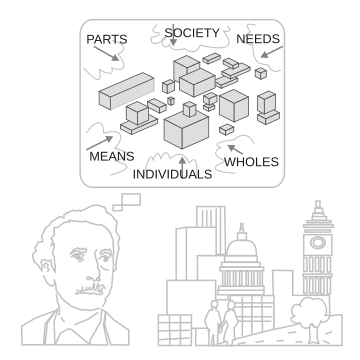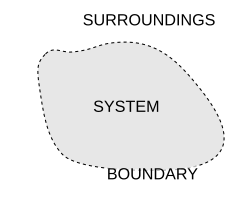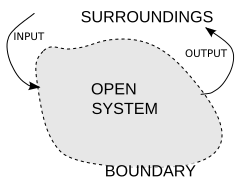Systems thinking facts for kids
Systems thinking is a way of making sense of the complexity of the world by looking at it in terms of wholes and relationships rather than by splitting it down into its parts. It has been used as a way of exploring and developing effective action in complex contexts, enabling systems change. Systems thinking draws on and contributes to systems theory and the system sciences. See Dana Meadows, Thinking In Systems: A Primer
Contents
History
Ptolemaic system versus the Copernican system
The term system is polysemic: Robert Hooke (1674) used it in multiple senses, in his System of the World, but also in the sense of the Ptolemaic system versus the Copernican system of the relation of the planets to the fixed stars which are cataloged in Hipparchus and Ptolemy's Star catalog. Hooke's claim was anwered in magisterial detail by Newton's (1687) Philosophiæ Naturalis Principia Mathematica, Book three, The System of the World (that is, the system of the world is a physical system).
Newton's approach, using dynamical systems continues to this day.
Feedback control systems

By 1824 the Carnot cycle presented an engineering challenge, which was how to maintain the operating temperatures of the hot and cold working fluids of the physical plant. In 1868 James Clerk Maxwell presented a framework for, and a limited solution to the problem of controlling the rotational speed of a physical plant. Maxwell's solution echoed James Watt's (1784) centrifugal moderator (denoted as element Q) for maintaining (but not enforcing) the constant speed of a physical plant (that is, Q represents a moderator, but not a governor, by Maxwell's definition).
Maxwell's approach, which linearized the equations of motion of the system, produced a tractable method of solution. Norbert Wiener identified this approach as an influence on his studies of cybernetics during World War II.
Bell system
- One policy, one system, universal service —Theodore Vail
In 1876 Alexander Graham Bell patented the telephone and later founded Bell Telephone and its successors. The term universal service, came from Theodore Vail in 1907, and has economic, legal and business ramifications including the communications systems of the Bell System.
The difficulties of reliably transmitting messages at continental scale required entire departments of the Bell system, and generations of technologies to overcome the problems.
By the Nyquist–Shannon sampling theorem, who were both employed by Bell, the sampling frequency must be 8 kHz for reasonable transmission of human voices.
The bipolar junction transistor (1948). invented at Bell Laboratories, helped to usher in the integrated circuit, particularly by the invention of the self-aligned gate (1967).
The discovery of the cosmic microwave background occurred at Bell Laboratories and was awarded the Nobel prize in 1975.
Applications
- "So, how do we change the structure of systems to produce more of what we want and less of that which is undesirable? ... MIT’s Jay Forrester likes to say that the average manager can ... guess with great accuracy where to look for leverage points—places in the system where a small change could lead to a large shift in behavior".— Dana Meadows, (2008) Thinking In Systems: A Primer p.146
Characteristics
-
- "...What is a system? A system is a set of things ... interconnected in such a way that they produce their own pattern of behavior over time. ... But the system’s response to these forces is characteristic of itself, and that response is seldom simple in the real world".—Dana Meadows
- Subsystems serve as part of a larger system, but each comprises a system in its own right. Each frequently can be described reductively, with properties obeying its own laws, such as Newton's System of the World, in which entire planets, stars, and their satellites can be treated, sometimes in a scientific way as dynamical systems, entirely mathematically, as demonstrated by Johannes Kepler's equation (1619) for the orbit of Mars before Newton's Principia appeared in 1687.
- Black boxes are subsystems whose operation can be characterized by their inputs and outputs, without regard to further detail.
- "system: (1) An integrated whole even though composed of diverse, interacting, specialized structures and subjunctions".
- Political systems were recognized as early as the millennia before the common era.
- Biological systems were recognized in Aristotle's lagoon ca. 350 BCE.
- Economic systems were recognized by 1776.
- Social systems were recognized by the 19th and 20th centuries of the common era.
- Radar systems were developed in World War II in subsystem fashion; they were made up of transmitter, receiver, power supply, and signal processing subsystems, to defend against airborne attacks.
- Dynamical systems of ordinary differential equations were shown to exhibit stable behavior given a suitable Lyapunov control function by Aleksandr Lyapunov in 1892.
- Thermodynamic systems were treated as early as the eighteenth century, in which it was discovered that heat could be created without limit, but that for closed systems, laws of thermodynamics could be formulated. Ilya Prigogine (1980) has identified situations in which systems far from equilibrium can exhibit stable behavior; once a Lyapunov function has been identified, future and past can be distinguished, and scientific activity can begin.
Systems far from equilibrium
Living systems are resilient, and are far from equilibrium. Homeostasis is the analog to equilibrium, for a living system; the concept was described in 1849, and the term was coined in 1926.
Resilient systems are self-organizing;
The scope of functional controls is hierarchical, in a resilient system.
Frameworks and methodologies
Frameworks and methodologies for systems thinking include:
- Critical systems heuristics: in particular, there can be twelve boundary categories for the systems when organizing one's thinking and actions.
- Critical systems thinking, including the E P I C approach.
- Ontology engineering of representation, formal naming and definition of categories, and the properties and the relations between concepts, data, and entities.
- Soft systems methodology, including the CATWOE approach, for example.
- Systemic design, for example using the double diamond approach.
- System dynamics of stocks, flows, and internal feedback loops.
- Viable system model: uses 5 subsystems 1 2 3 4 5.
See also
 In Spanish: Pensamiento sistémico para niños
In Spanish: Pensamiento sistémico para niños
- Systems Engineering
- Management cybernetics
- Operational research




